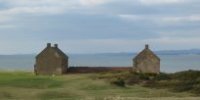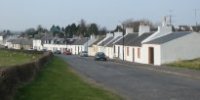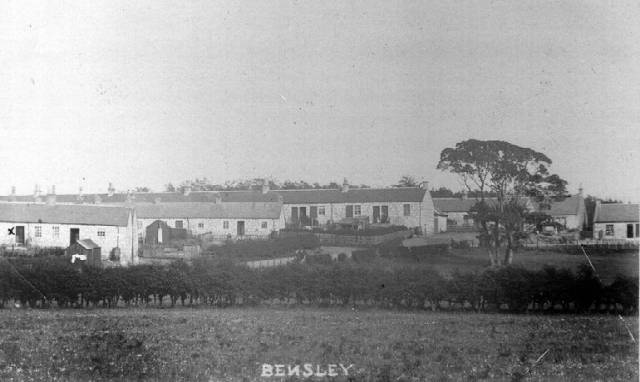 |
 |
 |
 |
Ayrshire Miners' Rows 1913 |
 |
Copyright notice: Links to this site are welcomed. However none of the material on the site may be duplicated in any form. The copyright of the articles is the property of the authors. Copyright of the web pages is the property of David McClure. |
Ayrshire Miners' Rows: Section 4.
BENSLIE, PARISH OF KILWINNING.
Messrs. A. Finnie & Son.
Benslie is a village about 400 yards further up the main road, belonging to the same colliery company as Fergushill. There are 57 houses in all, stone built, with an earth-closet for every four houses. There are neither washing-houses nor coalhouses. [42]
Rents.
There are two double apartment houses at 1s 6d a week rent; the other double houses are 1s 3d per week. There are 14 single apartment houses at 1s a week rent. All have a small garden in front, but few cultivate them.
Water.
There is but one pump of spring water, which is said to be good.
Paths.
The paths are unpaved, with the consequent muddy fronts.
Age,
The village is about 67 years old.

photo from Francisco Haro, January 2005.
ANNBANK, PARISH OF TARBOLTON.
Geo. Taylor & Co. Description of village.
Annbank is a large village, wholly mining, containing 236 houses, with a population of somewhere about 1100. Looking north the rows face each other for the length of about 25 houses, when they open up into a square of 44 houses, thence continuing the rows face each other for about 250 yards further up. This portion of the village is built continuously on both sides, a close, or pend, giving admittance to the back at intervals of about 8 or 10 houses.
The topmost portion consists of a half-square and a single row.
The rows run along each side of the main roan, and are built of brick throughout.
Material.
Built between 50 and 60 years ago, there were originally only about 20 two apartment houses, but from time to time openings were made between two houses to accommodate the largest families, and a number of years ago rooms were added behind, till now there are about 50 per cent. of the houses which have two apartments.
Accommodation. Measurement.
The single houses have two inset beds, and the newer rooms two iron bedsteads, the rent of which is 1s and 1s 8d per week. The kitchen measures 16 feet by 12 feet, the rooms 16 feet by 12 feet. The rooms have wooden floors.
Closets. etc.
There is a dry-closet for every two houses, a coalhouse for every house, and a washing-house for every five. Closets and coalhouses are at the back.
Paths.
The paths are unpaved and are often muddy, though a curbstone which fronts the paths helps to keep it clean.
Water.
Loch Bradan water is supplied, though many of the inhabitants prefer the village pump, which gives a good supply of good hard water.
Further building.
The Colliery Company is presently building additional rows of rooms to the one apartment houses. The Company constantly employ a man as scavenger. [44]
MOSSBLOWN, PARISH OF TARBOLTON.
Owned by Wm. Baird & Co.
Mossblown is a village, wholly mining, of 179 dwellings of two apartments, except twelve cottages, which have three apartments.
Where situated.
It is in the parish of Tarbolton, and within two or three hundred yards from Annbank Station. The larger half of the village was built about sixteen years ago, the other half about four.
Type of house.
The houses are of a fairly good type.
Paved pathways.
One commendable feature is that all the pathways are of concrete. This is good both for the tenant and for the house. The whole village is built of brick.
Nos. 1 and 2 Rows.
The older and larger half of the village consists of two rows on the north side of the G. & S.-W. Railway. One of them has 28 houses of two apartments.
Dimensions.
The kitchen measures 15 feet by 13½ feet, the room 13½ feet by 10½ feet.
Accommodations as to closet, etc.
There is a washing-house for every six tenants and a dry-closet for every three, with covered ashpits. These last leave much to be desired, some of them being very dirty. There are coalhouses for all.
Where placed.
All these conveniences are placed behind the row.
Water supply.
There is a fair supply of gravitation water from Loch Bradan. The rent of these houses is 2s 6d a week.
No. 2 Row.
The other row of this half of the village has 69 two apartment houses, in every point the same as the first row.
Wooden floors.
I should have said that all the houses have wooden floors. There are small gardens in front of the second row, all nicely cultivated. The drying green is at the back.
Newer half of village.
The newer half of the village is on the south side of the G. & S.-W. Railway, and consists of two rows of 32 and 38 two apartment houses, and a third row of 12 three apartment houses, called 'the cottages'.
Dimensions.
The apartments of the double houses are slightly smaller than those in the older rows, the kitchen measuring 15 feet by 12 feet and the room 12 feet by 10½ feet.
Water-closets here.
There is a water-closet for every three tenants, and a washing-house for every six. There are ashpits and coalhouses, and all these conveniences are under one roof, placed in front of the doors only 20 feet away. This is to be regretted in houses so lately built.
Conveniences: where placed.
It is not only unsightly to have them here, but it is conceivably dangerous to health, as we were informed when we [45] visited the village (6th December, 1913) that well into the Autumn of this year there was what might be termed a plague of flies.
Water taps in washing-house.
There are water taps in the washing-houses of these rows.
Rent.
The rent is 3s a week.
The Cottages. Front and back doors. Lobby and scullery.
The Cottage Row has 12 dwellings of three apartments each with a front and back entrance, a nice lobby, and a good sized scullery fitted with a kitchen sink and water tap.
Flower pots.
There are nice flower plots at the front inside wooden railings.
Dimensions.
The kitchen measures 13½ feet by 12 feet, the large room 13½ feet by 12 feet, and the bedroom 12 feet by 11 feet.
Accommodation, closets, etc.
There are water-closets, washing-houses, etc., in the same proportion as in the other rows.
Rent.
The rent is 5s a week.
Remarks.
These cottages could be called first class if there were baths attached. The rent, too, for the average working man is almost prohibitive; but with rents which could be paid by the average worker, and a bathroom to each of the tenants these cottages are what we could commend as suitable for our people. Mossblown is a decided improvement on many of the villages in the county.
DRUMLEY, PARISH OF TARBOLTON.
Owned by George Taylor & Co., Ayr Colliery.
Drumley is a small village of 36 two apartment house standing near the side of the Ayr and Mauchline road, about a quarter of a mile from Annbank Station.
Age.
It was built by the Ayr Colliery Co. from twelve to sixteen years ago.
ist Row. How built.
The first row is of two storeys, the kitchen below, the room above, and consists of 20 dwellings, ten on each side standing back to back.
Dimensions.
The kitchens measure 15 feet by 12 feet and the room about the same.
Rent.
The rent is 1s 8d a week.
Accommodation, closets, etc.
There is a dry-closet for every family, and a washing house for every five families, with coalhouses and open ashpits. These are 30 feet from the front doors, and some of the ashpits, when we saw them on 6th December, 1913, were very full and dirty.
Water supply.
There is a water supply from Loch Bradan.
Unpaved paths.
The pathways are unpaved, and in wet weather very muddy. The open syvor was sluggish and rather dirty. [46]
2nd Row.
The second row has 16 two apartment houses. This row is only one storey.
Dimensions.
The kitchen measures 17 feet by 12 feet, the room 12 feet by 12 feet.
Accommodation, closets, etc.
There is the same accommodation as to washing house, closets, etc.., all under one roof and only 27 feet from the front.
Remarks.
These places give the rows a dirty appearance, and must be against the health of the inhabitants. The ashpits here were also very full and dirty, and the open syvor was dirty too.
Rent.
The houses are built of brick, and the rent is 1s 8d a week.
WOODSIDE, PARISH OF COYLTON.
Owned by George Taylor & co., Ayr Taylor.
Woodside is a village of 37 houses standing on the side of 'the Ayr and Stair road.
1st Row.
The first row, approaching from Ayr, has 16 single houses. Each of these measures 15½ feet by 12½ feet, with a rent of 1s a week.
Thatched Row.
The next row has six single houses. These are thatched and are of a poor type.
Other Rooms.
The next three houses are single apartment ones, and the remaining 12 are of two apartments. These are very small, the kitchen being 12 feet by 11 feet and the room 10½ feet by 9 feet.
Rent.
These are rented at 1s 6d a week. In several cases families have taken two single apartment houses, in which case the rent is 1s 8d a week.
Accomodation, closets, etc. Poor sanitary arrangements.
There is a washing-house for every six houses and a dry-closet for every three. There are coalhouses, but only the semblance of ashpits. What there is of them were very filthy when we saw them on 6th December, 1913. They are all placed at the back. There were no locks on any of the closet doors, and some of the closets were unspeakably dirty. The womenfolk complained bitterly against the lack of closet accommodation.
Unpaved. Dirty open syvors.
The paths, both at front and back, are unpaved but fairly clean. The open syvors were sluggish and dirty.
Gardens.
There are gardens at the back, in the cultivation of which the men take a keen interest. The people here are of a good type, and deserve better accommodation.
CONNEL PARK, PARISH OF NEW CUMNOCK.
Owned by the New Cumnock Collieries, Ltd. How built. When built.
This is a considerable village occupied wholly by miners or men working about mines. It is built in rows, some of which form half-squares. The older rows are of stone, built by the late Lanemark Coal Co. about 40 years ago. The [47] newer rows are of brick, some of them built by the Lanemark Coal Co., some by the reconstructed Coal Co. known as the New Cumnock Collieries, Ltd. The village is a mile distant from New Cumnock railway station, on the Dalmellington road.
Condition of drainage, of fronts, and backs.
We visited it on the 13th of November, 1913, and found most of the rows in a miserably dirty condition, due to bad or ill-kept drainage and to unpaved fronts and backs.
Closet accommodation, etc.
With the exception of one or two rows, to be mentioned later, there are no water-closets. It is bad enough to be without water-closets, but the arrangement as to dry-closets, ashpits, and coalhouses is simply disgraceful. In one large row these are under one roof, only 27 feet from the back kitchen door, and some of the houses look directly into the ashpit and closet outlets, which, when we saw them, were full of human filth. In some rows there are no doors even to these closets, which prevents womenfolk especially from using them, and precludes the possibility of friends or acquaintances visiting here. There are, too, a considerable number of single apartment houses which, with the miserable closet accommodation provided, must make the lives of people miserable who desire to observe the commonest decencies.
Scavenging inadequate.
There is a scavenger employed by the Colliery Co., but the provision made for cleansing, judging from the condition of the village when we saw it, is altogether inadequate.
Water supply.
There is a supply of gravitation water which is brought from Hare Hill, 5 or 6 miles away.
Populations, names, etc., of the different rows.
The following are the population, names of rows, and accommodation of the rows in the order in which we visited them :
New Football Row.
The New Football Row contains 26 two apartment houses with sculleries, in which there is a boiler. There are 176 persons in this row, 97 above working age and 79 children. Coalhouses are provided for each house, with six dry-closets for the row. Some of these closets had a depth of three inches of water lying on the floor. Coalhouse, closet, and ashpit are under one roof, the contents of the closet being exposed and within 30 feet of the scullery. The paths, both back and front, are, literally, quagmires. The lower half of this row is often flooded from lack of attention to the drains, and before one front door was a heap of filth, paper, and mud which had been taken from the trap and left lying. The thing must be seen to be believed, and for the privilege of living here one must pay 3s 6d a week. This row is built of brick, which would facilitate its being levelled with the ground, the only thing it is fit for. [48]
The measurements are - kitchen 15 feet by 12 feet, rooms 12 feet by 12 feet, back kitchen 8 feet by 8 feet.
Old Low Boig Row and Old Football Row.
The Low Old Boig Row and the Old Football Row form an oblong square. This square contains 19 two apartment houses and 15 single apartment houses, each having a scullery. It is built of stone, and about 40 years old. The rent for the double house is 2s 9d per week, for the single 1s 10d. Kitchens measure 14 feet by 13 feet, and the rooms are the same size. The scullery is 11 feet by 7 feet, with a sloped roof. These sculleries, like all in the village, have a boiler for washing purposes. There are no coalhouses here, except such wooden sheds as are put up by the tenants themselves; and 12 dry-closets, 6 ashpits give accommodation to 193 souls, viz., 123 over working age and 70 children. These closets and ashpits are inside the square. There are small gardens also inside the square. The paths in front of the doors are unpaved, and are, in wet weather, a litter of mud.
Long Row.
The Long Row is built of stone, and contains 12 two apartment houses and 16 single, each kitchen measuring 16½ feet by 11½ feet, the rooms 12 feet by 9 feet. Each has a scullery. The rents are- room and kitchen 2s 6d, single house 1s 10d. There are 141 persons here, 89 over working age and 52 children. The accommodation here is the worst in the village - two dry-closets of three apartments each with no doors of any kind, and two open ashpits which, when we saw them, were filled to overflowing. The paths are unpaved and dirty. The houses about 50 years old.
Store Row.
The Store Row was originally built as 16 two apartment houses, but is now used as 20 single apartment houses and 6 double. As now arranged these houses are back to back. There is a water-closet for every two apartments, a coalhouse for every tenant, and a washing-house for every four. There are four ashpits for the row, which are only 20 feet from the kitchen door, the people in the front having to carry the ashes to the back. The apartments measure 16½ feet by 11 feet. The row is built of brick, the rent 4s for double and 2s for single apartment. There are 111 persons here. In one single kitchen we discovered two married couples besides a girl of 18 years and three children. In another, four adult Spaniards kept house by themselves. The unpaved pathways were in a horrible condition. The houses are about 10 years old.
Railway Terrace.
The Railway Terrace is a better class of house. There are 34 houses of one room and kitchen and scullery, with coalhouses and water-closets. The terrace is of brick, just built, and the rent is 4s a week. There are 209 persons here. [49]
Bankbrae Row, left hand side.
Bankbrae Row, left hand side, consists of 32 two apartment houses, with sculleries. The kitchens measure 12½ feet by 11 feet, rooms 12 feet by 11 feet. Sixteen are rented at 3s 6d a week and sixteen at 4s. There is a water-closet for every two families, and an ashpit for every eight. All have coalhouses. This row is new. There are 190 persons here.
Bankbrae, right hand side, and High Boig Rows.
There are 8 two apartment houses and 15 single houses here, built of stone. The double house costs 2s 6d a week for rent, the single 1s 10d. Each house has a scullery. Kitchens measure 16 feet by 11½ feet, but the rooms are very much smaller. There are 143 persons here, 86 over working age and 57 children. There are two dry-closets of three compartments each, having no doors, as well as other two which have doors. No coalhouses.
Honeymoon Row.
Honeymoon Row contains 43 families. It is built of brick in two blocks. It was originally intended for 31 families only, but several two apartment houses have been converted into single apartment houses. The rent for double houses is 3s 6d a week and 2s for single. The population here is 211 viz., 125 over working age and 86 children. There are three dry-closets of three compartments each, having no doors and three open ashpits. Each family has a coalhouse. On man in this row who has several daughters was compelled to convert his coalhouse into a pail closet. The sanitary arrangements are disgusting. These houses are about 14 years old.
CRAIGBANK, PARISH OF NEW CUMNOCK.
Owned by the New Cumnock Collieries Ltd.
Craigbank village was formerly owned by the late Bank Colliery, but now belongs to the New Cumnock Collieries Ltd. The village forms a square, and has a population of 247 persons. The back row of this square has two earth closets, one of which has no roof. No one can ask friends to come here. How the people who are condemned to live her manage to exist is a mystery. It is alleged that one lady visitor lately had to go out into the open moss, no other accommodation being available. She is not likely to repeat the experience. Such is the shameful state of affairs here. The houses are two apartment ones, many of them consisting of two storeys, the room above the kitchen.
New houses at Craigbank.
There are a number of new houses in course of erection presently (13th November, 1913), of a superior character. They consist of two rooms and a kitchen, the kitchen 12 feet by 12 feet, the rooms each 12 by 10. There is a bathroom, water-closet, scullery, and coal bunker all on the premises There is an oven grate in the kitchen and a sink. The rooms [50] are also provided with handsome grates. If these houses are not too highly rented they will be a boon to the mining families who get them.
BURNFOOT ROW, PARISH OF NEW CUMNOCK.
Owned by the New Cumnock Collieries, Ltd.
Burnfoot Row, about three miles from New Cumnock, `consists of four blocks of houses, containing in all 41 houses. It was formerly owned by the Lanemark Coal Co., now by the New Cumnock Collieries, Ltd. Burnfoot might, in common parlance, be termed the limit. My colleague has described Drongan, Cronberry, and Darnconner, which seemed to be the worst possible. Burnfoot could give all of them points, and win in a contest for abominations.
Population.
There are 234 human beings in this village. There are six earth closets of two compartments each, having no doors, and with ashpits attached, the contents of which had long ago overflowed their walls, and were strewn about in a manner indescribable. Three of these abominations are set in between the blocks, the gables of the houses forming the walls of the alley leading to them, with a wall from gable to gable completely shutting out egress to the field. There are no washing-houses and no coalhouses, except the wooden sheds built by the tenants.
1st Block.
The first block consists of ten two apartment houses, the kitchen measuring 14 feet by 11½ feet, the room 11 feet by 9 feet. The rent is 2s 3d a week.
2nd Block.
The second block consists of 12 single apartment houses, measuring 16 feet by 11 feet. The rent 1s 8d a week.
3rd Block.
The third block has 8 houses, the same as to dimensions as the first block.
4th Block.
Fourth block has 11 two apartment houses, with sculleries, in which there is a boiler. The rent here is 2s 9d a week. The pathways to and before all the houses are unpaved, and very, very dirty in wet weather.
CRAIGMARK, PARISH OF DALMELLINGTON.
Owned by Dalmellington Iron Co., Ltd.
Craigmark lies about a mile from the town of Dalmellington, in the parish of Dalmellington, and consists of six rows containing 52 two apartment houses and 21 single, 73 in all.
Although the frontage is unpaved the pathways are fairly clean. Each house has a water-closet and a coalhouse, with a washing-house for about every four tenants. All the houses are built of stone, and are between 60 and 70 years old. The rents are - double houses 2s 3d per week, and singles 1s 9d. [51]
There are two inset iron beds in the kitchens, but some of the houses are rather small. One kitchen might be described as a lobby, as it measures 14 feet by 8 feet. The room was equally narrow, and this house contained 11 persons. Many of the people complain of the lack or repairs, and some of those we saw were indeed greatly in need of attention. The sewage arrangements, too, leave much to be desired. The arrangement consists of what seems to be a settling tank, and we were informed that it was never cleaned and was very offensive in hot weather. Some repairs and some attention to the sewage would greatly increase the comfort of the people.
FARDLEHILL, NEAR KILMARNOCK.
Owned by Caprington Coal Co., Ltd.
Fardlehill is a small place about a mile from Kilmarnock, on the Irvine Road, containing 10 two apartment houses. There are two rows - one of four, the other of six houses.
Dimensions.
The kitchens measure 12 feet by 10½ feet, the rooms 10 feet by 9 feet.
Closet, and other accommodation.
There are two dry-closets, with doors, and two open ashpits, but there are no washing-houses nor any coalhouses, the tenants requiring to keep their coal below the bed.
Floors.
The floors are of brick tiles, but underneath the beds there is nothing but the bare earth. When we visited this place (26th November, 1913) we found women doing their washing on the middle of the kitchen floor, which is bad for all concerned.
Unpaved pathways.
The pathway is unpaved and very dirty in wet weather. At No. 1 row we found the cesspool choked, in consequence of which a considerable quantity of mud was collected, and the house in front very damp.
Subsidence.
There seems to be considerable subsidence here, as one of the gables was shored up, and several rents were seen in the walls.
Age, Stone Built, and Rent.
The houses look very old, are built of stone, and are rented at 1s 7½d per week.
Water.
There is a supply of gravitation water.
KELK PLACE, NEAR KILMARNOCK.
Owned by Caprington Cola Co., Ltd. State of repair. Dimensions and number of apartments. Brick built and age.
Kelk Place is a village of 30 dwellings, also about a mile from Kilmarnock on the Irvine road. These at one time must have been superior houses, but are now sadly out of repair. One house which we visited (26th November, 1913) was very dilapidated owing to the ceiling being badly broken, [52] and there were large rents across. This is due to subsidence from underground workings. The houses are of four apartments. The kitchen measures 18 feet by 12 feet, one of the rooms might pass, 10 feet by 9 feet, but the other two are mere closets, 9 feet by 6 feet each, and all of them are entered in a line from the kitchen. There are no beds in the kitchen. All are built of brick, and are said to be about 70 years old.
Water.
There is a supply of gravitation water.
Accommodation.
There are no washing-houses. There are two dry-closets to every six families, one with a door, the other without a door, with one very small open ashpit to every two closets. There are small wooden coalhouses. There are gardens behind, a small plot in front, and many of them are cultivated.
Pathways dirty and unpaved.
The pathways are unpaved and dirty, the cesspools being within a couple of feet of the door.
Rent.
The rent is 1s 10½d a week.
Remarks.
These houses, which are built in five blocks of six each, might be made tolerable if washing-houses and water-closets were erected. We would strongly urge that the front pathways should be paved here. This would add greatly to the comfort and cleanliness of these houses, as well as of all the other houses which have unpaved pathways.